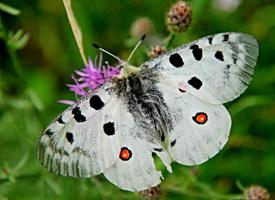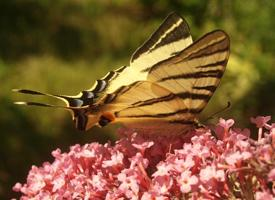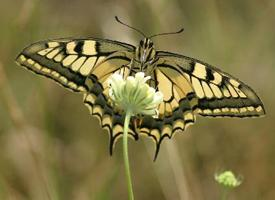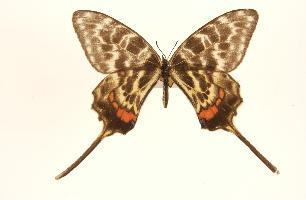
Váhy a míry
| Délka rozpětí křídel | od 7 do 8,4 cm |
|---|
Stav ohrožení
| Ohrožen |
Popis zvířete
The Apollo butterfly, scientifically known as Parnassius apollo, is a captivating species that belongs to the Papilionidae family, which is renowned for its large and colorful members. This species stands out due to its distinctive appearance and its fascinating life cycle, making it a subject of interest among both scientists and butterfly enthusiasts.The Apollo butterfly exhibits a striking color palette, primarily characterized by its pristine white wings. These wings are adorned with eye-catching red eye-spots, which serve not only as a mesmerizing visual feature but also as a defense mechanism against predators. The number and size of these red spots can vary significantly among individuals, contributing to the butterfly's diverse appearance. Additionally, the edges of the wings are bordered with black, adding a bold contrast that accentuates the butterfly's elegant form.
With a wingspan that can reach up to 80 millimeters, the Apollo is considered a relatively large butterfly. Its size, coupled with its distinctive wing pattern, makes it one of the more easily identifiable species within its habitat.
The Apollo butterfly is found across a wide range of elevations, from sea level to high mountain meadows, primarily in the European continent. It favors sunny, open areas where larval host plants, such as species of the Sedum family (stonecrop), are abundant. These specific plants are crucial for the survival of the Apollo larvae, which feed on them after hatching from eggs laid by the female butterfly.
One of the most remarkable aspects of the Apollo butterfly is its life cycle, which is closely tied to its habitat. After mating, the female lays her eggs on the underside of the host plant leaves. Upon hatching, the larvae feed on the leaves, growing rapidly. As they progress through various stages of development, they eventually form a chrysalis from which the adult butterfly emerges, ready to start the cycle anew.
Unfortunately, the Apollo butterfly is considered vulnerable and is facing threats from habitat destruction and climate change. Its dependence on specific host plants and habitats makes it particularly susceptible to changes in its environment. Conservation efforts are underway in various parts of Europe to protect this species and its habitat, aiming to ensure that future generations can continue to enjoy the sight of this beautiful butterfly.
In summary, the Apollo butterfly (Parnassius apollo) is a visually stunning and ecologically significant species, with its unique appearance, fascinating life cycle, and the challenges it faces in the wild. Its presence enriches the biodiversity of its habitat, making it a valuable species for conservation efforts.
Podobná zvířata
Nové fotografie zvířat
Top 10 zvířat
- Chinese water dragon (Physignathus cocincinus)
- Galápagos tortoise (Geochelone nigra complex)
- Dolphin gull (Leucophaeus scoresbii)
- Japanese macaque (Macaca fuscata)
- Colombian red howler (Alouatta seniculus)
- Sea urchins (Echinoidea)
- Diana monkey (Cercopithecus diana)
- Moustached guenon (Cercopithecus cephus)
- Colossal squid (Mesonychoteuthis hamiltoni)
- Common house mosquito (Culex pipiens)


